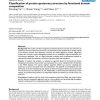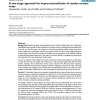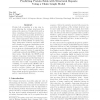215 search results - page 14 / 43 » Predicting the protein-protein interactions using primary st... |
BMCBI
2006
13 years 8 months ago
2006
Background: We describe Distill, a suite of servers for the prediction of protein structural features: secondary structure; relative solvent accessibility; contact density; backbo...
BMCBI
2008
13 years 8 months ago
2008
Background: We present a novel method of protein fold decoy discrimination using machine learning, more specifically using neural networks. Here, decoy discrimination is represent...
BMCBI
2006
13 years 8 months ago
2006
Background: The number and the arrangement of subunits that form a protein are referred to as quaternary structure. Quaternary structure is an important protein attribute that is ...
BMCBI
2006
13 years 8 months ago
2006
Background: Protein topology representations such as residue contact maps are an important intermediate step towards ab initio prediction of protein structure. Although improvemen...
ICML
2005
IEEE
14 years 9 months ago
2005
IEEE
Protein fold recognition is a key step towards inferring the tertiary structures from amino-acid sequences. Complex folds such as those consisting of interacting structural repeat...



